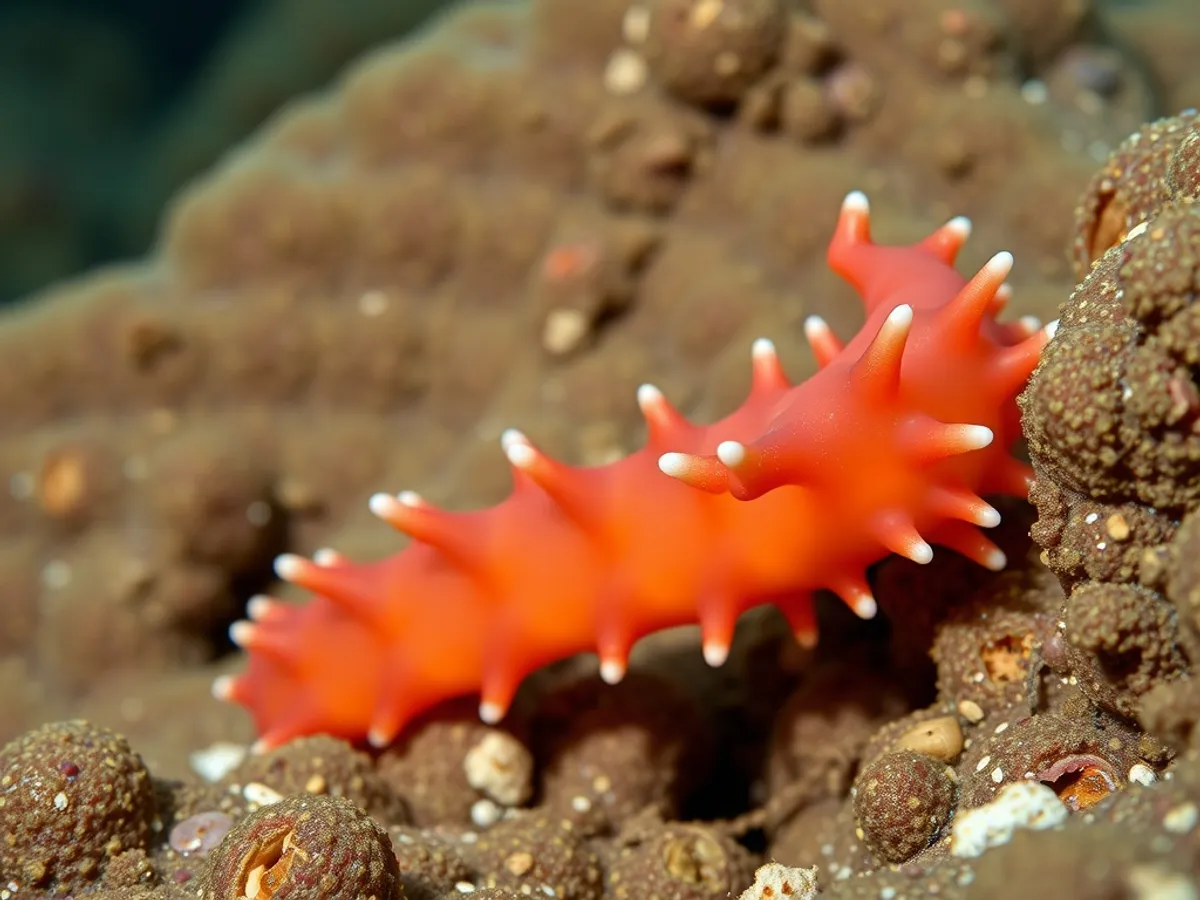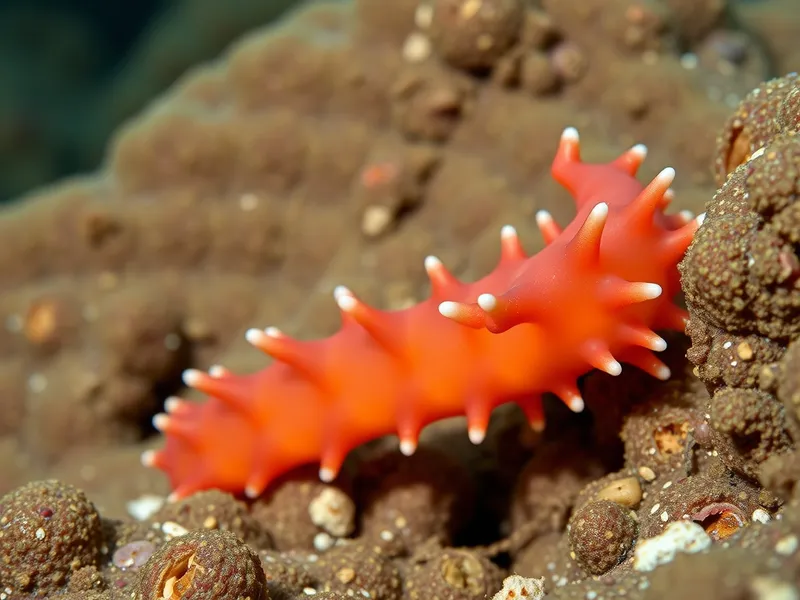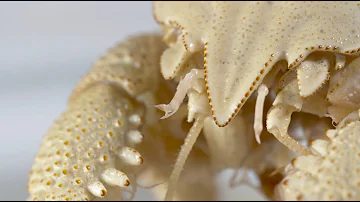
Deep-sea hydrothermal vent tube worm
Riftia pachyptila

Meet the Deep-sea hydrothermal vent tube worm
The deep-sea hydrothermal vent tube worm, Riftia pachyptila, is a remarkable invertebrate found near hydrothermal vents on the ocean floor at depths exceeding 2,000 meters. These worms can grow up to 2.4 meters in length and lack a digestive system, instead relying on a symbiotic relationship with chemosynthetic bacteria housed in a specialized organ called the trophosome. The bacteria convert toxic hydrogen sulfide from vent water into organic molecules that nourish the worm. Their bright red plumes, used for gas exchange, are packed with hemoglobin adapted to bind both oxygen and sulfide. Tube worms form dense colonies and are key members of vent ecosystems, supporting unique communities in otherwise inhospitable environments.
Classification
Invertebrate
Habitat
Deep-sea hydrothermal vents
Diet
Chemosynthetic symbiont-dependent
Lifespan
2-5 years
Conservation
Least Concern
Weight
Up to 1.6 kg
📖Fascinating Facts
Extreme Environment
Deep-sea hydrothermal vent tube worms thrive at depths over 2,000 meters where no sunlight penetrates and water pressure is immense.
Symbiotic Survival
These worms rely entirely on chemosynthetic bacteria to convert toxic chemicals from vent fluids into sustenance, a process called chemosynthesis.
Colony Builders
Tube worms can form dense colonies that provide habitat for a variety of other vent-dwelling species, making them ecosystem engineers of the deep sea.
📋Detailed Description
Riftia pachyptila, the giant deep-sea hydrothermal vent tube worm, is a vestimentiferan annelid that inhabits the extreme environments of hydrothermal vent fields, typically at depths ranging from 2,000 to over 3,000 meters along mid-ocean ridges, notably the East Pacific Rise. Adults can reach lengths of up to 2.4 meters and diameters of 4-5 centimeters, making them among the largest known tube-dwelling marine invertebrates. The worm's body is encased in a chitinous tube, which it secretes and uses for protection against predators and harsh vent conditions. Lacking a mouth, gut, or anus in the adult stage, Riftia relies entirely on a dense population of endosymbiotic, sulfur-oxidizing bacteria housed within a specialized organ called the trophosome. The bright red plume, which protrudes from the tube, is highly vascularized and rich in hemoglobin, enabling efficient uptake of both oxygen and hydrogen sulfide from the vent water. This unique hemoglobin can bind sulfide without being poisoned, a rare adaptation. Riftia forms dense aggregations, often numbering thousands of individuals, creating complex biogenic habitats that support a diverse community of vent fauna. The worms exhibit rapid growth rates, with juveniles reaching full size in just 2-3 years, an exceptional feat given the nutrient-poor nature of the deep sea. Their life span is estimated at up to 40 years. Riftia's anatomy is highly specialized for its symbiotic lifestyle, with reduced sensory and locomotive structures, reflecting its sessile, tube-dwelling existence.
💡 Did you know?
Tube worms can survive in total darkness at temperatures near freezing, except for the immediate vicinity of the vent where water can exceed 350°C, thanks to their highly specialized adaptations.
🔬Research & Sources
🎭Behavior & Social Structure
Riftia pachyptila is a sessile organism, remaining anchored within its tube for life after initial larval settlement. It exhibits minimal movement, limited to the extension and retraction of its plume in response to environmental stimuli such as changes in water chemistry, temperature, or the presence of predators like vent crabs and fish. The plume is extended to maximize gas and sulfide uptake, and retracted rapidly when disturbed. Riftia does not actively hunt or feed; instead, it relies on its symbiotic bacteria for nutrition. Socially, Riftia forms dense colonies, with tubes often intertwined, which may facilitate larval settlement and enhance local microhabitat stability. There is no evidence of complex social interactions or territoriality. Daily routines are dictated by the fluctuating chemistry of vent emissions, with plume activity adjusting to optimize resource acquisition.
👶Reproduction & Life Cycle
Riftia pachyptila is dioecious, with separate male and female individuals. Spawning is believed to occur year-round, as hydrothermal vent conditions are relatively stable and lack pronounced seasonal cycles. Fertilization is external; both sexes release gametes into the water column, where fertilization occurs. The planktonic larvae, called trochophores, drift with ocean currents for several weeks before settling near active vents, where they metamorphose and acquire symbiotic bacteria from the environment. There is no parental care post-spawning. Rapid growth is observed in juveniles, which can reach maturity within two years. Genetic studies suggest high dispersal potential, allowing Riftia populations to colonize new vent sites as old ones become inactive.
🛡️Adaptations & Survival
Riftia pachyptila exhibits numerous adaptations to the extreme vent environment. Its hemoglobin is uniquely adapted to bind both oxygen and hydrogen sulfide simultaneously, enabling survival in sulfide-rich, oxygen-poor waters. The trophosome, a large internal organ, houses dense populations of chemosynthetic bacteria that convert inorganic compounds into organic molecules, providing all the worm's nutritional needs. The chitinous tube offers protection from predators and toxic vent fluids. Riftia's rapid growth and reproductive rates are adaptations to the transient nature of hydrothermal vents, which can become inactive within decades. The worm's larvae are adapted for wide dispersal, increasing the likelihood of finding new vents. Reduced sensory organs and lack of a digestive tract reflect its reliance on symbionts and sedentary lifestyle.
📚Research Sources
🎨Cultural Significance
Riftia pachyptila has become an icon of deep-sea biology and is frequently featured in documentaries, educational materials, and museum exhibits as a symbol of life’s adaptability to extreme environments. It has inspired scientific and public fascination since its discovery in 1977, challenging previous assumptions about the limits of life on Earth. While it holds no direct traditional or economic value, Riftia plays a significant role in scientific discussions about the origins of life and the potential for life on other planets, particularly in analogous environments such as the subsurface oceans of Europa or Enceladus.
🔬Recent Research & Discoveries
Recent research on Riftia pachyptila has focused on its genome, revealing genes involved in symbiosis, sulfide detoxification, and rapid growth. Studies using advanced imaging and molecular techniques have elucidated the mechanisms of symbiont acquisition and maintenance. Ongoing research investigates Riftia’s role in vent ecosystem succession and resilience, especially in the context of vent field disturbances. The species is also a model for studying chemosynthesis and the evolution of symbiotic relationships. Notably, the discovery of unique hemoglobin structures in Riftia has informed biomedical research into oxygen transport and sulfide toxicity.
🎥Wildlife Videos

Hydrothermal Vents | Oases in the Deep Sea
The process of chemosynthesis is similar to photosynthesis. Both can be defined as the creation of organic matter from the fixation ...
Natural World Facts

Hydrothermal vents: Explore a bizarre deep ocean habitat
As the Monterey Bay Aquarium prepares for the launch of the 2022 exhibit, "Into the Deep: Exploring Our Undiscovered Ocean," ...
MBARI (Monterey Bay Aquarium Research Institute)

Into the Abyss: Chemosynthetic Oases (Full Movie)
Deep Sea Chemosynthetic Oases Full Movie. Exploring hydrothermal vents, cold-seep habitats, and food-falls including ...
Natural World Facts

Life at hydrothermal vents | Natural History Museum
Hydrothermal vents are unique environments. Dr Adrian Glover and Dr Maggie Georgieva are looking at how animals adapt to ...
Natural History Museum

The Wonderful World of Deep Sea Worms
Polychaete worms in the deep sea are among the most diverse organisms in the ocean. From giant tube worms and Pompeii ...
Natural World Facts

David Attenborough on Hydrothermal Vents
Brian Nicholas
🌍Habitat Information
The Deep-sea hydrothermal vent tube worm typically inhabits Deep-sea hydrothermal vents environments. Deep-sea hydrothermal vent tube worms have adapted to their environments with specialized features and behaviors.
Primary Habitat:
Deep-sea hydrothermal vents
More detailed habitat information will be available soon.
🛡️Conservation Status
The Deep-sea hydrothermal vent tube worm is currently classified as Least Concern. Conservation efforts are crucial for preserving this species for future generations.
Common Threats:
- 🏠Habitat loss and fragmentation
- 🌡️Climate change impacts
- 🎯Hunting and poaching
- 🏭Human-wildlife conflict
⚠️Threats & Conservation Challenges
Currently, Riftia pachyptila faces few natural predators, with some vent crabs and fish preying on juveniles or exposed plumes. The main challenges are environmental: hydrothermal vents are ephemeral, and populations must recolonize new sites as old vents cool and become inactive. Human threats are emerging, particularly from deep-sea mining for polymetallic sulfides, which can destroy vent habitats. Climate change may also alter deep-sea circulation and chemistry, potentially impacting vent ecosystems. Despite these risks, Riftia populations are currently stable, and the species is listed as Least Concern by the IUCN. However, the vulnerability of vent communities to habitat destruction is a growing conservation concern.
🔬Scientific Classification
Scientific Name
Riftia pachyptila
Classification Hierarchy
🔍 About Taxonomic Classification
Taxonomic classification is a hierarchical system used by scientists to classify and organize living organisms based on shared characteristics and evolutionary relationships.
The system moves from broad categories (Kingdom) to increasingly specific ones, with each animal's scientific name typically consisting of its Genus and species.
📝Community Notes
Share your observations and insights about the Deep-sea hydrothermal vent tube worm with our community of wildlife enthusiasts.
Join Our Community
Sign in to share your observations and connect with fellow wildlife enthusiasts.
Sign In to ContributeNo community notes yet
Be the first to share your observations about the Deep-sea hydrothermal vent tube worm!
Explore Deep-sea hydrothermal vent tube worm
Select a tab above to learn more about this amazing animal.
📸Photo Gallery
No photos available for this animal yet.
🌟Discover More Wildlife
Continue your journey of discovery with more fascinating animals from our database
